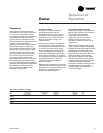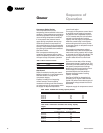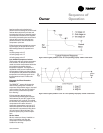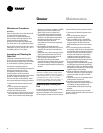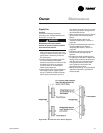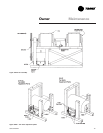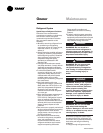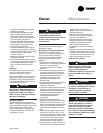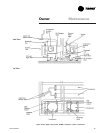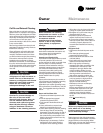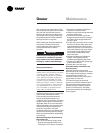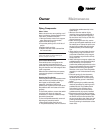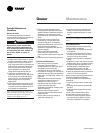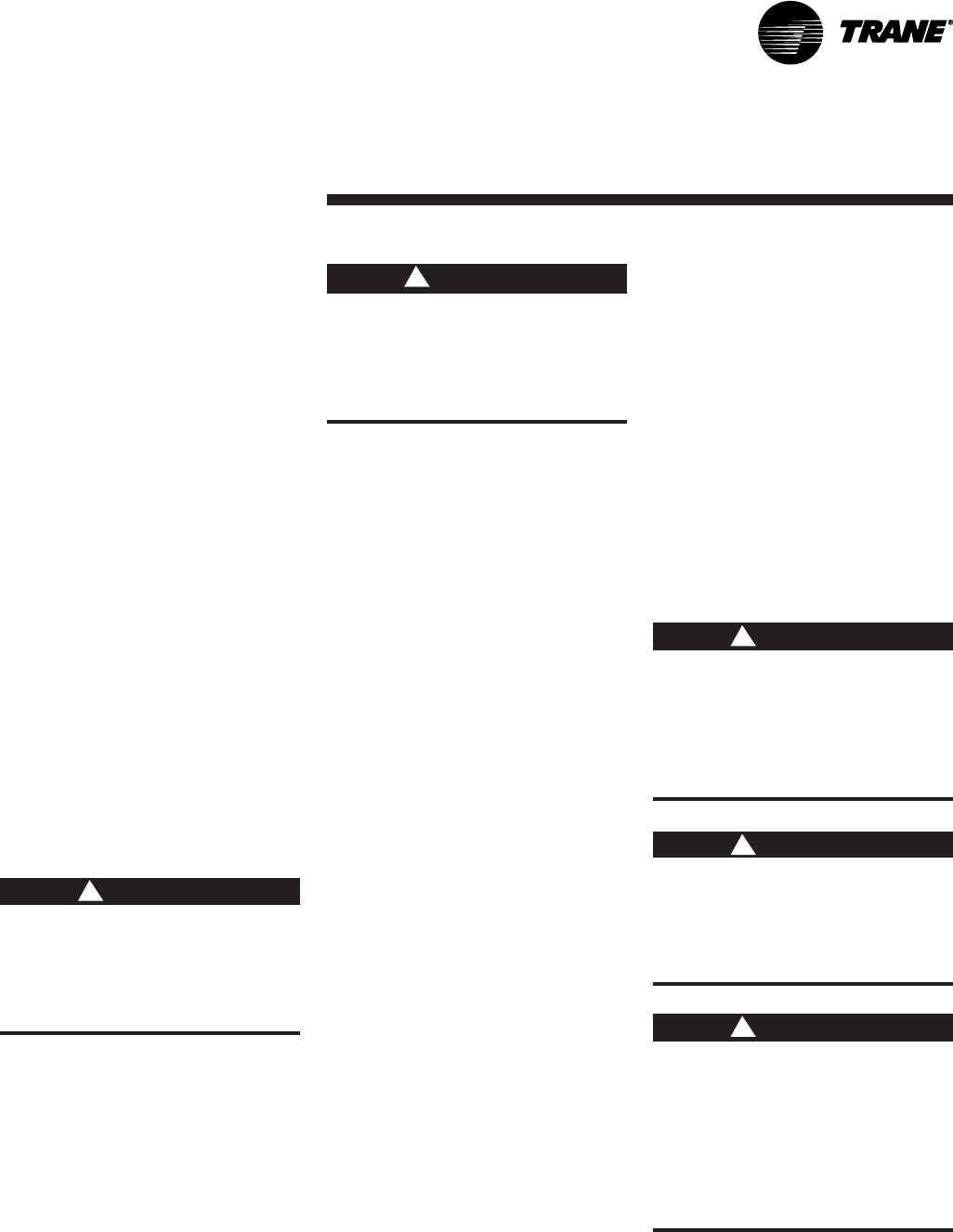
SCXG-SVX01B-EN 103
refrigerant service work such as
gauges, hoses, vacuum pumps, and
recycling equipment.
• Stay aware of unit enhancements,
conversion refrigerants, compatible
parts, and manufacturer’s
recommendations that will reduce
refrigerant emissions and increase
equipment operating efficiencies.
Follow specific manufacturer’s
guidelines for conversion of existing
systems.
• To assist in reducing power generation
emissions, always attempt to improve
equipment performance with improved
maintenance and operations that will
help conserve energy resources.
Refrigerant Leak Testing
Do not work in a closed area
where refrigerant or nitrogen
gases may be leaking. A
sufficient quantity of vapors may
be present and cause injury or
death.
Do not use oxygen, acetylene, or
air in place of refrigerant and dry
nitrogen for leak testing. A
violent explosion may result
causing injury or death.
Always use a pressure regulator,
valves, and gauges to control
drum and line pressures when
pressure testing the system.
Excessive pressures may cause
line ruptures, equipment damage,
or an explosion which may result
in injury or death.
Caution: Do not operate the
compressors without some
refrigerant in each circuit. Failure
to do so may damage the
compressors.
Charge refrigerant into the system by
Refrigerant System
Special Note on Refrigerant Emissions
Follow the Trane recommended
procedures on operation, maintenance,
and service to endure refrigerant
conservation and emission reduction.
Also, pay specific attention to the
following:
• When removing refrigerant from air
conditioning or refrigerating equipment
recover for reuse, recycling,
reprocessing (reclaim), or properly
destroy it.
• Always determine possible refrigerant
recycling or reclaiming requirements
before beginning recovery. Questions
about recovered refrigerants and
acceptable refrigerant quality
standards are addressed in ARI
Standard 700.
• Use approved containment vessels and
safety standards when shipping
refrigerant containers.
• To minimize emissions while recovering
refrigerant, use recycling equipment.
Always attempt to use methods that
will pull the lowest possible system
vacuum while recovering and
condensing refrigerant into
containment.
• When leak checking with trace
refrigerant and nitrogen, use HCFC22
(R22) rather than CFC12 (R12) or any
other fully halogenated refrigerants. Be
aware of any new leak test methods
which eliminate refrigerant as a trace
gas.
• When cleaning system components or
parts, do not use CFC11 (R11) or CFC
113 (R113). Refrigeration system clean-
up methods using filters and dryers are
recommended. Do not use solvents
which have ozone depletion factors.
Properly dispose of used materials.
• Take extra care to properly maintain all
service equipment directly supporting
Owner Maintenance
nitrogen into the system to raise the
pressure to 100 psig.
2. Use a halogen leak detector, halide
torch, or soap bubbles to check for
leaks. Check interconnecting piping
joints, the evaporator coil connections,
and all accessory connections.
3. If a leak is detected, release the test
pressure, break the connections and
reassemble it as a new joint, using
proper brazing techniques.
4. If no leak is detected, use nitrogen to
increase the test pressure to 150 psig
and repeat the leak test. Also, use soap
bubbles to check for leaks when
nitrogen is added.
5. Retest the system to make sure new
connections are solid.
6. If a leak is suspected after the system
has been fully charged with refrigerant,
use a halogen leak detector, halide
torch, or soap bubbles to check for
leaks.
Evacuation
For field evacuation, use a rotary style
vacuum pump capable of pulling a
vacuum of 100 microns or less.
When connecting the vacuum pump to a
refrigeration system, it is important to
manifold the pump to both the high and
low side of the system. Follow the pump
manufacturer’s directions.
Do not use a Meg ohm meter or
apply power to the winding of a
compressor while it is under a
deep vacuum. This may damage
the motor windings.
Refrigerant Charging
After leak testing and evacuating the
system, charge liquid refrigerant into the
system through the liquid line valve. After
some refrigerant has entered each
circuit, charge gaseous refrigerant into
the suction line shrader valve with the
compressors running.
ƽƽ
ƽƽ
ƽ
CAUTION
!
ƽƽ
ƽƽ
ƽ
CAUTION
!
ƽƽ
ƽƽ
ƽ
WARNING
!
ƽƽ
ƽƽ
ƽ
WARNING
!
ƽƽ
ƽƽ
ƽ
WARNING
!



